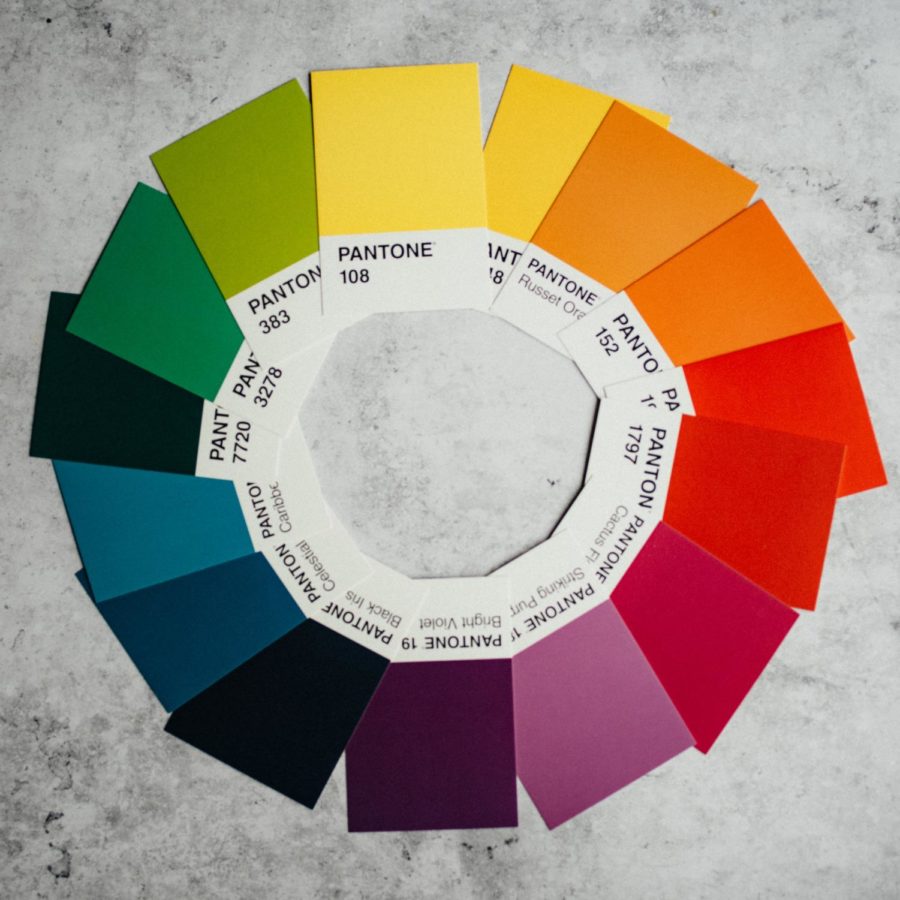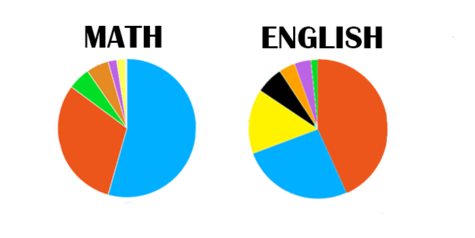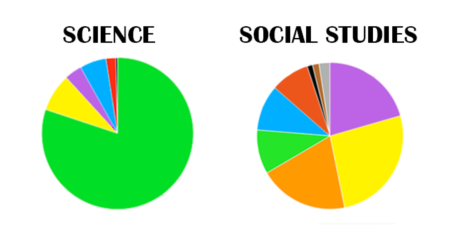The Correlation of Specific Colors to Specific Academic Subjects, a Matter of Intense Debate
An analysis of some of the reasons why students associate certain colors with certain academic subjects.
Bronx Science students have strong opinions regarding associating academic subjects with specific colors.
At some point during your school career, you may have heard students strenuously argue with each other, saying, “Math is blue” and ”No, Math is red,” whether it was throughout the hallways or on social media. This long-standing debate is the classic, “What color are subjects?” I recall back when I was a ninth grader buying school supplies for Bronx Science, I sparked an argument throughout my entire social circle after complaining about not being able to find a blue notebook for my math class. Since then, I’ve noticed this argument reopen around the same time of the year, or periodically throughout the school year.
When asked for the justification of their responses, many simply say, “Because I’m just right” or “Any answer other than mine is wrong.” Seemingly unchangeable, these responses were likely caused by an instinctual response developed from a young age. “It’s kind of like second nature, because we’ve all been associating the colors with academic subjects since we were five years old,” said Vicky Tang ’24. Those who did provide their reasoning to me, however, had diverse opinions, which were caused by a variety of factors.
Some students developed this from their learning environment. “Naturally, I did have a preconceived idea of what color each subject should be, but I think it is partially due to the color of the classroom itself, and the materials that you use within it,” said Justin Seecharan ’22.
Personally, I have always correlated shapes with different colors, because the tables in my kindergarten class were each labeled with a shape and a specific color. Since then, I’ve associated trapezoids with the color red, circles with the color blue, hexagons with the color yellow, and triangles with green. Though they were all shapes, I associate geometry in general with the color green because my earliest memories consists of me sitting at the green triangle table. However, I also associate math in general with blue because of my sixth grade math teacher — a diehard New York Rangers fan whose room was covered in predominantly blue, and who also often wore a vertically striped blue shirt. On top of the general colors of their classrooms, most of the students who responded to my survey said that they were required to color code their academic subjects in elementary or middle school, and some of them were directly assigned colors by their teachers, which they have continued to use ever since.
Other students use their favorite colors for their favorite subjects. “Subjects that I enjoy are more likely to be associated with colors that I like. For instance, I enjoy studying history, so I associate it with the color purple, my favorite color,” said Arianne Browne ’22. Understandably, if you don’t like a subject, you probably wouldn’t want to associate your favorite color with it.
Another possible explanation can be synesthesia, a neurological condition where an individual’s senses are intertwined with each other. Synesthesia is said to affect approximately 4.4% of the population. While there are several forms of synesthesia, a more well known type is grapheme color synesthesia, a condition in which one associates colors with letters or words. For example, someone with synesthesia may associate the letter ‘A’ with red, or the word ‘Wednesday’ with azure blue. At the moment, there is much more research that needs to be done in order to fully understand the condition, but what students experience with their desire for subjects and colors may be related to this condition in some way.
Lastly, others may just associate subjects based on the general perceived personalities of colors, which possibly goes hand in hand with synesthesia. For example, red is typically associated with anger or frustration, which may lead a student to using red for an academic subject in which they may struggle. It could also be more of a physical association, as well. For example, the majority of people associate science with green, because they often think of nature and greenery.
Now, here is the moment that you have been waiting for; here are the results of my survey of Bronx Science students, involving 250 participants:
54.2% voted that Math is BLUE, followed by 30.3% red.
41% voted that English is RED, followed by 24.7% blue.
78.5%% voted that Science is GREEN, followed by 8% yellow.
25.8% voted that Social Studies is YELLOW, followed by 20.3% purple and 19.5% orange.
There were many compelling arguments made as students defended their color choices:
English Language
Alex Neampong ’22 said, “English as a class is considered a very classic cornerstone of the educational curriculum. A common image associated with very classic and uptight classes, teachers, or schools is a shiny red apple. Red is also the color of strong emotion, such as rage and confidence, and these are all strong themes found in the compelling texts of English courses.”
Victoria Diaz ’22 said, “English is red because many vintage books have red leather covers. Red is a classic color, and it’s just perfect for English.”
Josephine Kinlan ’22 said, “English is pretty. People write in pretty words with eloquent connotations and convey meaningful ideas. Purple is elegant and pretty. English is purple. Language is how our world connects, how different people across the globe of different skin tones and histories and ethnicities and habits communicate with each other, and language classes are the bridge between those different communities with different characteristics.”
Holly Shortell ’23 said, “English is blue and math is red. So for math, we’ve all cried out in frustration trying to solve a math problem. When you cry, your eyes are red. And red is associated with anger. What subject makes you angrier than math? Exactly. English is blue. First, this is because of the pen color. For tests (and especially the Advanced Placement exams), you’re only allowed to use blue or black pen. And sometimes blue is associated with sadness and calmness. Books are sometimes sad, and reading is very calming. So, blue is the color of English.”
Mathematics
Alex Neampong ’22 said, “Mathematics, by contrast, requires cool, calculating, level-headedness in order for one to be an effective and efficient mathematician. While the side effects of taking a math class may be strong emotions, those who cast aside their emotions are able to succeed in math classes. Furthermore, on the color spectrum, the premier ‘cool’ color is none other than blue, a perfect fit for calculating mathematicians.”
Leila Buchan ’22 said, “I believe the color blue is very fitting for a subject like mathematics, and I would truly feel uncomfortable seeing it associated with another color. Blue can mean different things. It is psychologically proven to associate with feelings of order and stability, and I truly agree with this description when I am participating in a mathematics class. Unlike other subjects, there is a clear cohesive answer when solving mathematics, and that truly brings peace to my heart. Even though the same could possibly be said about other subjects over the color blue, for me, the subject of mathematics alone is not associated with any other color than blue.”
Tamar Padwa ’24 said, “Yellow is the math color because yellow is bright in a strong way. Math is barely controlled frustration simmering below the surface. Math is difficult and passive-aggressive and all-consuming. Yellow is the in-between color that always pops up, the color that you can’t escape. The sun? It’s yellow. Chemistry? It’s math. You can’t escape. I can’t escape. Yellow. Yellow. Yellow. Math. Math. Math.”
Susan Cohen ’23 said, “Math is absolutely red because of how rigid it is. When I think of red, I think of rigidness and grit. In math, there are definitive answers to every problem. There is no way to debate over what the answers to a problem could be. There is an absolute right and an absolute wrong. Red represents anger. Many students in my math classes are always very passionate about the subject and sometimes get angry over certain math problems. Even their faces turn red.”
Bronx Science Precalculus teacher Mr. Liang said, “Carl Friedrich Gauss once said that math is the queen of science and purple is associated with royalty, so math is purple.”
Science:
Joleen Chen’22 said, “STEM subjects such as science and mathematics are indubitably cool-toned colors. Math requires a unique logic oriented way of thinking when it comes to solving problems. When I try to personify logic, I think of a person who is relaxed and calculating, which is correlated with a blue hue of a color. Science sometimes is categorized as yellow. However, I strongly disagree with this statement. Science should be green. Science is the study of the world around us, and green is synonymous with life. Physics would be the exception for the only time yellow is acceptable for a science (sun = yellow, light = yellow).”
Alex Neampong ’22 said, “I don’t think I need to explain why science is green; just look at the Bronx Science official school colors, green and yellow! However, the most common theme of a science class is understanding more about the world, to which the world consists of many macro organisms. The fundamentals of macro organisms and their interactions is the primary producer, almost all of which are green due to chloroplasts. Plants fall under the category of science, at least for biology. For something like chemistry, that comes from the common image of test tubes and beakers with some unknown concoction of chemicals, which are almost always green. In something like earth science, the earth from space is a sphere of green blobs surrounded by a blue ocean. Blue has been previously taken, and there is enough to universally agree that science should be green regardless.”
Dakota Barnes’23 said, “I’m only o.k. with you disagreeing with me on anything except science. That is most definitely green, for what do you think of when you think of science? Or better yet, what do you draw to represent science? You’d most likely draw a beaker, right? Well, what color would you color in the fluid in the beaker? The answer is green. And with that, I rest my case.”
Social Studies:
Josephine Kinlan ’22 said, “Through my elementary and middle school experiences probably has the most credit, I would say since social studies is red because it deals with lots of war, death, and blood, all of which is red. Also the crowns of kings and queens typically have red jewels in them.”
Louisiana Stahl ’23 said, “Okay so, first of all, the earth — which is what social studies essentially is, the study of the world around us — is blue and green, and because green is reserved for science, social studies has to be blue.”
***
With many responses, Bronx Science students were eager to share their opinions on this matter, giving strong opinions in order to prove that they were “right.” While I, and many other students, will continue to have a firm stance on the colors that we already use for each academic subject, I have started to find myself more open to others’ perspectives and found it intriguing to learn about the various backstories that each student has for each academic subject and its associated color.
Tamar Padwa ’24 said, “Yellow is the math color because yellow is bright in a strong way. Math is barely controlled frustration simmering below the surface. Math is difficult and passive-aggressive and all-consuming. Yellow is the in-between color that always pops up, the color that you can’t escape. The sun? It’s yellow. Chemistry? It’s math. You can’t escape. I can’t escape. Yellow. Yellow. Yellow. Math. Math. Math.”
Alvina Rahman is a Chief Graphic Designer and Managing Editor for 'The Observatory' yearbook and a Staff Reporter' for 'The Science Survey' newspaper....













